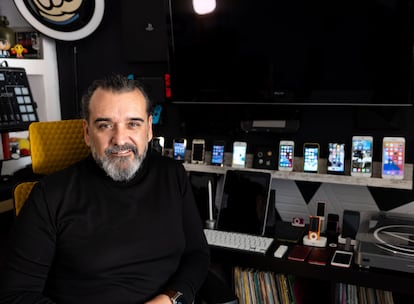Those who resist upgrading their mobile phones are irresistible | Technology

“It has the longest battery life,” “it’s the best phone we’ve ever made.” Slogans sound grandiose at the presentations of new mobile models. Prices match the epic narrative: 959 euros for the iPhone 16, but up to 1969 euros for the most expensive model, and the same happens with Samsung, which sells the Galaxy S24 Ultra for 1199 euros and easily exceeds 1500 euros. on the Galaxy Fold 6. Spain is one of the countries with the highest mobile phone penetration in the world. According to the National Markets and Competition Commission, in 2023 there were 59,500,000 mobile lines for a population of just under 49 million inhabitants. Does this rage over getting new cell phones respond to a real need or excessive consumerism?
“Mobile device manufacturers make people believe that real innovation is happening and reinforce the idea that new necessarily means better. It’s perceived as obsolete,” explains Martha Castillo, marketing manager for Back Market. This portal for buying and selling refurbished mobile phones is experiencing a golden moment; According to them, their turnover in 2023 increased by 23% compared to the previous year, to 2.157 million euros. According to research by Rentic and the University of Spain, the average mobile phone changes every two to three years. Global Impact Report on Refurbished Electronics (carried out by the French Agency for Ecological Transition (ADEME) in 2022.
Consumers cling to their phones
Californian Chris Matyszczyk is one of the veterans in the world of the blogosphere, and also one who resists changing cell phones for the sake of it. Clinging to his battered iPhone 12 since 2020, he sees no reason to renew his contract. “I usually go to the Apple Store to talk about the improvements to the new iPhone when it goes on sale, and I laugh when I hear that the camera is better than the previous one,” Matyszczyk explains. “It’s still a functional item and mine continues to work great despite the years,” he adds.
The same is happening with Samsung with its latest innovations in high-end mobile phones. In the manufacturer’s own comparator, the differences between the current flagship Galaxy Fold 6 and the previous Fold 5 are barely noticeable. The screen is larger and brighter, the dust resistance is higher, but the camera battery is almost the same and identical. . What arguments can a potential buyer of the device find? What’s more, both Apple and Samsung have committed to creating artificial intelligence, and Apple doesn’t even include it in its hardware, guaranteeing that it will come in the future. Until it becomes popular youtuber Marques Brownlee highlights the irony of the situation in his analysis of the iPhone 16: “You can’t review something that hasn’t arrived yet,” citing the words of Tim Cook, who announced that the iPhone 16 was designed solely with the future in mind. the promise of Apple Intelligence, an unearthly service whose details are unknown and whose absence leaves the company’s flagship mobile phone crippled. The problem is that the market is accustomed to these incremental improvements that are unlikely to bring anything new.
Basque businessman José (he prefers not to give his last name) is another of those who left the update wheel, but in this case by accident: “One day the camera on my iPhone stopped working,” he says, and after going through an approved technical Apple service, he was told that the cost of repairs was so high that buying a new terminal was almost worth it. “It was at that moment that the seller himself dissuaded me from buying the latest model and recommended the previous one, saying that “there are almost no differences.” In fact, this employee saved him 200 euros during the purchase process and all for get lost some improvements bonus which I really didn’t need.

Ecological footprint of mobile sales
Mallorcan teacher David Arraez has been stuck on his iPhone 12 Pro Max for four years: “I don’t upgrade because what comes out isn’t worth it,” he explains. According to Arras, manufacturers act this way because “people keep buying” and extract minimal improvements to justify the cost for a niche market that always wants the latest model. And he’s right: Samsung’s sales continue to rise in the midst of the Galaxy S24, and so does Apple, despite lowering iPhone 16 sales forecasts.
But these rebels who refuse to jump through hoops and buy the latest model every year have made another compelling argument: the environmental impact. “By purchasing a refurbished mobile phone, you save up to 77,000 liters of water, reduce e-waste by 89% and avoid the extraction of 243.60 kg of raw materials, which is equivalent to the weight of twelve bicycles,” explains Castillo, a marketing specialist.” manager at Back Market. What is the recovery process? It’s a way to break the upgrade cycle that those who want to stay up to date with their mobile devices are caught in.
These are used mobile phones, tested and most importantly with a guarantee, just like a new mobile phone. These devices undergo extensive testing similar to that carried out at manufacturers’ repair centers. Faulty parts are replaced, batteries are assessed or replaced, and the appearance of the phone is improved. After repair, the phone is ready for sale, and the terminal can be purchased at a price that is 70% lower than the market price.